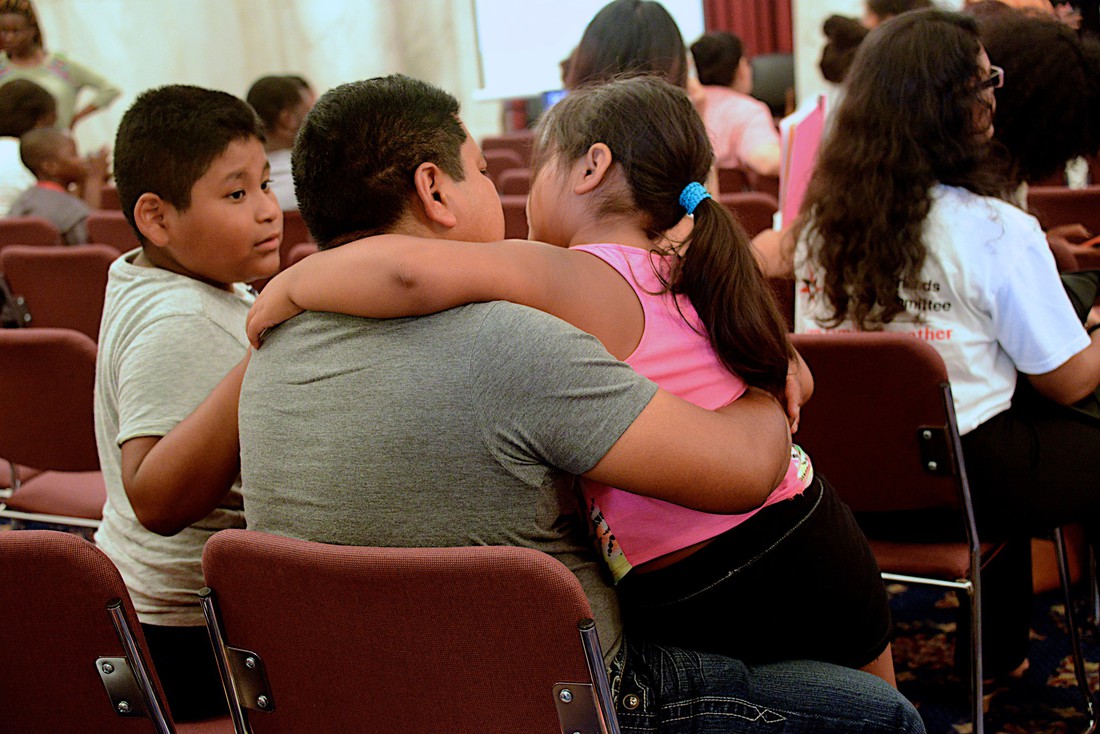
The Piña family sits together at a briefing on immigration and deportation in Washington, D.C. in 2014. Karen Elliott Greisdorf / AFSC
This morning, the United States Supreme Court announced that they were evenly divided in a four -to -four split on U.S. v. Texas, the case challenging a Texas court’s injunction on President Obama’s 2014 executive actions on immigration.
If implemented, the executive actions would have expanded eligibility for the Deferred Action for Childhood Arrivals (DACA) program, as well as expanded eligibility to millions of parents of U.S. citizens and legal permanent residents, in what is referred to as the Deferred Action for Parents of Americans and Lawful Permanent Residents (DAPA) program. The programs would have positively impacted the lives of approximately five million immigrants living in the United States, giving them some measure of protection from deportation.
But what does it mean that the Supreme Court couldn’t reach a decision?
We asked Matthew Boaz, Alexandra Goncalves-Pena, Nicole Miller—members of AFSC’s legal team, all who work on immigrants’ rights issues in Newark, New Jersey—to tell us what we need to know. Here's what they had to say:
- People who are already DACA recipients will not be affected. Most importantly, the 2012 executive action that initially granted DACA is completely unaffected by this decision. Individuals who have received DACA status are still protected from removal.
- The decision is non-precedential. This means that no legal precedent was set about the president’s ability to issue these kinds of actions. This decision leaves the injunction in place, but the legality of the 2014 executive action has not yet been decided.
- The Department of Justice may file a petition for rehearing with the Supreme Court. The DOJ has 25 days to file the petition. This would temporarily prevent further proceedings from taking place in the lower courts. Given Senate Republicans’ refusal to act on Obama’s Supreme Court nominee, a rehearing, if granted by the Supreme Court, would still likely have to wait for a new president. If the DOJ does not file its petition, the case would presumably go back to the U.S. District Court for additional proceedings, but a quick decision is unlikely in this highly politicized climate. Since the Supreme Court was simply reviewing the lower court's decision granting a preliminary injunction, the U.S. District Court in Texas will most likely move forward with deciding whether the president has the authority to institute DACA/DAPA, almost certainly with appeals by the losing side.
- Many immigration advocates have questioned the authority of the U.S. District Court in Texas and the Fifth Circuit to make decisions that impact individuals nationwide, especially since there are states that recognize the huge benefit they would derive from the DACA and DAPA programs. They're considering filing suit in other parts of the country to call for the implementation of the executive actions there. This could potentially create a circuit split and thereby provide another avenue to get the executive actions back before the Supreme Court.
- Any future changes will likely be enacted by the next president. The presumptive Republican nominee Donald Trump has indicated that he would attempt to eliminate the DACA/DAPA protections and would perhaps overturn the previous executive action (though this has never been done by a U.S. president). The presumptive Democratic nominee Hillary Clinton has said that she would attempt to keep in place DACA/DAPA or even expand it to include parents of DACA recipients. However, we will not know for sure which policies will be enacted, or how, until January 2017 or later.
- What now for immigrants who met the expanded DACA/DAPA eligibility requirements? Unfortunately, there is currently no program they can apply for. If they have questions about their eligibility for these programs, be sure to contact a legal professional. In the meantime, they should try to abide by the guidelines already established for expanded DACA/DAPA. For example, continue collecting documents indicating physical presence in the United States and don’t leave the country if possible. It's important for them to remember: No physical application for these programs exist, so do not fill out anything or pay anyone for assistance with the filing of any documents. Speak only with licensed attorneys or representatives accredited by the Board of Immigration Appeals.
- It’s not over. Because no decision has been made, we must still “wait and see.” A decision from the Texas court will likely take several months or longer. This means that the upcoming elections and political process, as well as the future appointment of the next Supreme Court justice, will be important in determining the outcome of this case.
Although today's decision is a step backward, the fight for DACA/DAPA moves forward. In the meantime, AFSC will continue to support immigrant communities throughout the United States and advocate for the comprehensive, just, and humane immigration policies that are so necessary to provide the 11 million undocumented Americans nationwide with the protection from deportation that they and their families deserve.
We hope that this disappointing Supreme Court decision, along with continued Congressional inaction and disturbing anti-immigrant rhetoric espoused by some politicians and others, will only further mobilize communities across the country to call on Congress to enact fair immigration laws.